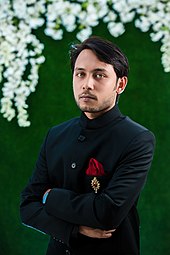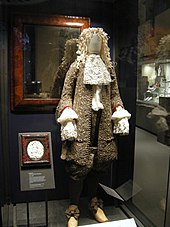
A wedding is a ceremony in which two people are united in marriage. Wedding traditions and customs vary greatly between cultures, ethnicities, races, religions, denominations, countries, social classes, and sexual orientations. Most wedding ceremonies involve an exchange of marriage vows by a couple; a presentation of a gift ; and a public proclamation of marriage by an authority figure or celebrant. Special wedding garments are often worn, and the ceremony is sometimes followed by a wedding reception. Music, poetry, prayers, or readings from religious texts or literature are also commonly incorporated into the ceremony, as well as superstitious customs.
A white wedding is a traditional formal or semi-formal wedding originating in Great Britain.

A bride is a woman who is about to be married or who is a newlywed.
Bridesmaids are members of the bride's party at some Western traditional wedding ceremonies. A bridesmaid is typically a young woman and often the bride's close friend or relative. She attends to the bride on the day of a wedding or marriage ceremony. Traditionally, bridesmaids were chosen from unwed young women of marriageable age.

Baraat or Varayatra is a groom's wedding procession in the Indian subcontinent. In North India, it is customary for the bridegroom to travel to the wedding venue on a mare, accompanied by his family members.

A groomsman or usher is one of the male attendants to the groom in a wedding ceremony. Usually, the groom selects close friends and relatives to serve as groomsmen, and it is considered an honor to be selected. From his groomsmen, the groom usually chooses one to serve as best man.

A boutonnière or buttonhole is a floral decoration, typically a single flower or bud, worn on the lapel of a tuxedo or suit jacket.

The bride of Christ, or the lamb's wife, is a metaphor used in number of related verses in the Christian Bible, specifically the New Testament – in the Gospels, the Book of Revelation, the Epistles, with related verses in the Old Testament.

The traditional Vietnamese wedding is one of the most important ceremonies in Vietnamese culture, which is influenced by Confucian and Buddhist ideologies.
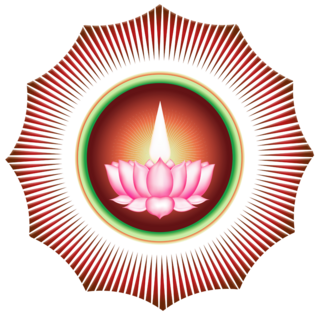
An Ayyavazhi wedding is the wedding custom within the Ayyavazhi belief system of South India. Usually Dharmagharttas, Panividaiyalars from Thangals or an older person experienced in Ayyavazhi assumes a role as a Guru and is seated in the Manvarai for leading the wedding ceremony.
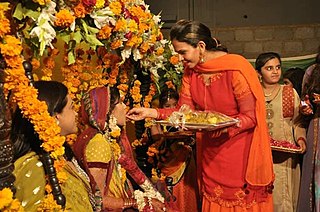
Marriage in Pakistan pertains to wedding traditions established and adhered by Pakistani men and women. Despite their local and regional variations, marriages in Pakistan generally follow Islamic marital jurisprudence. Marriages are not only seen as a union between a husband and a wife, but also an alliance between their respective families. These traditions extend to other countries around in the world where Overseas Pakistani communities exist.

Punjabi wedding traditions are a strong reflection of Punjabi culture with ritual, song, dance, food, and dress that have evolved over centuries.
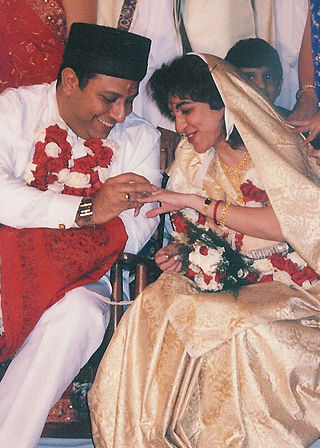
A Zoroastrian wedding is a religious ceremony in Zoroastrianism in which two individuals, a man and a woman, are united. In Zoroastrianism, marriage within the community is encouraged, and is greatly favored in religious texts. The following information will detail ceremony procedures and traditional processes for a Zoroastrian wedding.
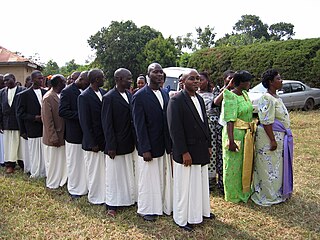
A kanzu is a white or cream coloured robe worn by men in the African Great Lakes region. It is referred to as a tunic in English, and as the Thawb in Arab countries. The kanzu is an ankle or floor length garment. It serves as the national costume of Tanzania as well as the Comoros, where it is called/pronounced 'Kandu' as well as thawb. The robe is also worn in some coastal Muslim regions of Tanzania and Kenya. The men of Uganda consider it their most important dress. Kanzu is a Ganda word of Swahili origin, which means "robe" or "tunic". In Tanzania, the term is used interchangeably with kaftan.
In the United States and Canada, weddings follow traditions often based on religion, culture, and social norms. Most wedding traditions in the United States and Canada were assimilated from other, generally European, countries. Marriages in the U.S. and Canada are typically arranged by the participants and ceremonies may either be religious or civil.

A vőfély is the Master of Ceremonies before, during and after a traditional wedding in Hungary. He wears a ribboned hat so he can be easily identified.

Indian wedding clothes refer to the traditional attire worn by a wedding couple and wedding guests.
Bahaghara is the Hindu wedding ceremony performed by Odia people in the Indian state of Odisha. It is the main ritual of an Odia Hindu wedding.
Shinto weddings, Shinzen kekkon, Shinzenkekkon, began in Japan during the early 20th century, popularized after the marriage of Crown Prince Yoshihito and his bride, Princess Kujo Sadako. The ceremony relies heavily on Shinto themes of purification, and involves ceremonial sake drinking of three cups three times, the nan-nan-san-ku-do. Shinto weddings are in decline. Fewer Japanese people get married, and those who do often choose Western-style chapel ceremonies.

